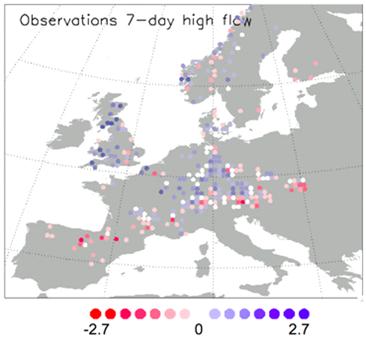Post a comment on the text below
4.3.1. Changes in flood flow
Available evidence suggests different patterns across Europe with increasing high flows in northern Europe, especially in western Britain and coastal Scandinavia. Regional patterns are, however, diverse, with many weak negative trends occurring in northern Europe as well, and a very mixed pattern in central Europe. Detection of a climate signal in hydrological observations of flood magnitude and frequency is difficult due to the confounding effects of long-term natural variability in climate, human disturbance of catchments and river systems, as well as the relatively short period of observation in most rivers. Stahl et al. (2011) analysed trends in 7-day maximum flows and found that the overall pattern largely confirms the results of national studies, i.e. – increasing high flows in northern Europe, with steepest trends in western Britain and coastal Scandinavia, but regional patterns are very mixed, with many weak negative trends also occurring in northern Europe, and a very mixed pattern in central Europe (figure 4.10). Conclusions from such evidence-based studies are limited in spatial scope to the areas where observed long-term flow data exists and are made available. For example, no data from south eastern Europe was included in the study by Stahl et al. (2011)
Figure 4.10 7-day maximum trends across Europe, 1962 – 2004

Source: Stahl et al. 2011
Note: Blue circles denote positive trends, red circles negative, with trend magnitude expressed in standardized units.
You cannot post comments to this consultation because you are not authenticated. Please log in.


